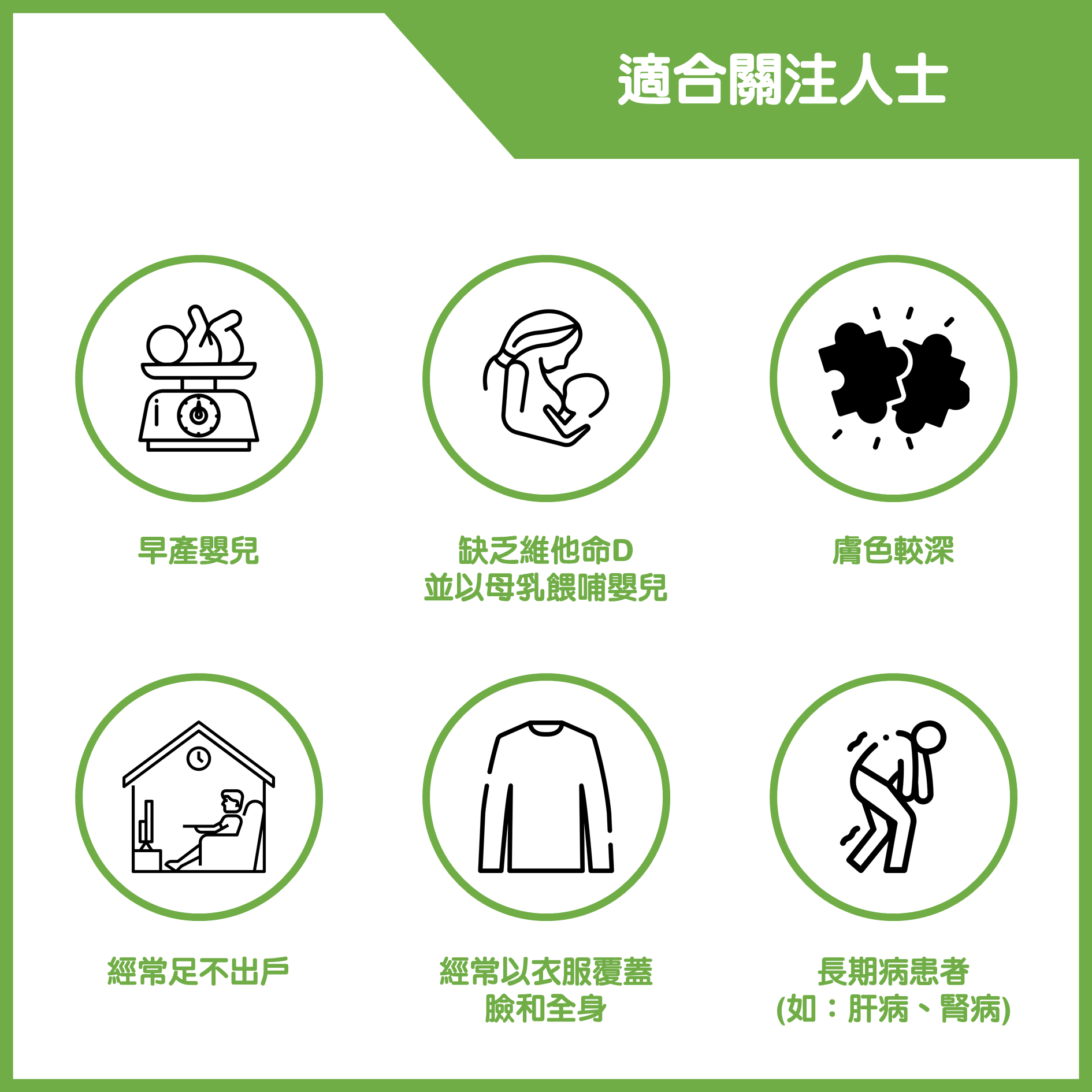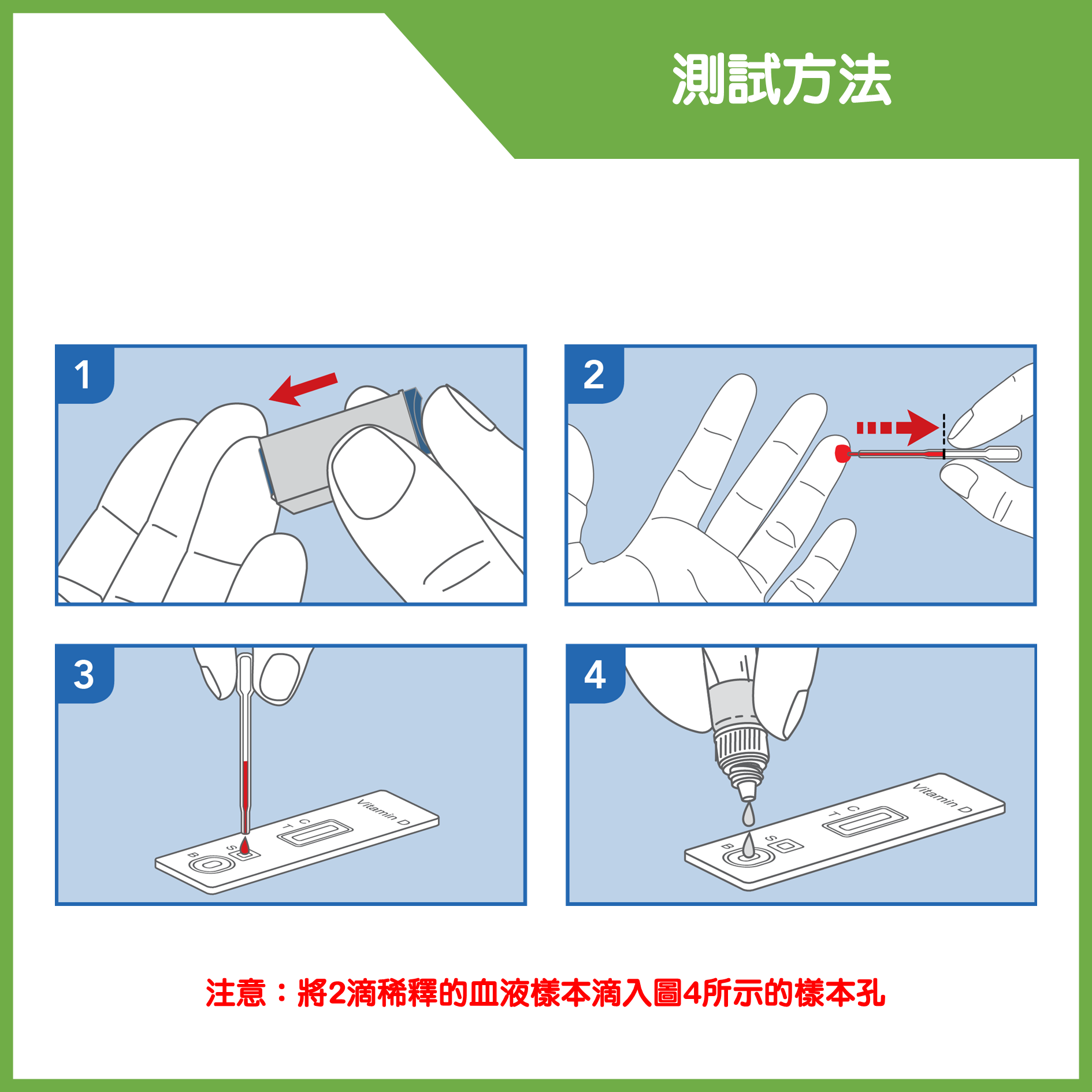
PRIMA_100066PRIMA Vitamin D test
Detail
- Accuracy 94.4%
- Results in 10 minutes
- Semi-quantitative detection of Vitamin D in blood
- Screening of Vitamin D deficiency
- Suitable for infants and children, pregnant women and adults
- Simple, clear and convenience
- CE marking (CE0483)
- Made in Switzerland, quality guaranteed
Delivery
Purchase Exceed $300 EnjoyFree Shipping
What is Vitamin D?
Vitamin D is essential for bone health. Vitamin D helps calcium absorption in the gut, and maintains normal levels of calcium and phosphate in blood, keeping bones strong. Most of the Vitamin D in our body is made when the skin is exposed to sunlight. A small amount of Vitamin D comes from foods.
Sun exposure and Vitamin D
•Vitamin D is formed when the skin is exposed to sunlight. Exposing to sunlight behind the window glass does not help you get Vitamin D because the glass blocks the ultraviolet B (UVB) rays in sunlight needed to make Vitamin D. Sun screen cream and skin pigments also reduce the formation of Vitamin D because it prevents UVB rays from reaching skin
•The amount of Vitamin D we get from sun exposure depends on how long and how much the skin is exposed, the skin colour, the season, the weather and the time of the day. To get more Vitamin D, it is best to expose larger area of your skin (e.g. arms, and lower legs) for a short period of time than a small area (e.g. face and hands) for a longer period
•For most people, 5 to 15 minutes of casual sun exposure of the hands, face and arms two to three times a week during the summer months is sufficient for keep the Vitamin D level high. People with darker skin need a longer period of sun exposure. Sunlight is generally less strong in winter. A longer sun exposure may be required the same level of Vitamin D in winter
Infants and Vitamin D
•Babies obtain a small reserve of vitamin D from mother before birth. After birth, babies need to get Vitamin D from sunlight, breastmilk (or formula milk if they are not breastfed), and from foods
•Breastmilk provides the best nutrition for babies. However, babies do not get much Vitamin D from breastmilk in particular when their mothers have low Vitamin D levels. In some countries, such as UK and US, breastfed babies are recommended to take
Vitamin D supplements
•Formula-fed babies do not usually need a supplement as Vitamin D is already added to infant formula
Hong Kong population and Vitamin D insufficient status
According to the study conducted by the The University of Hong Kong, the prevalence of insufficient or deficient Vitamin D levels was 90.1%^
People at risk of not getting enough Vitamin D
•Premature babies
•Babies born to mothers who are Vitamin D deficient or do not expose to sunlight, especially if they are breastfed exclusively
•Exclusively breastfed babies who have little sun exposure
•Babies and people with darker skin
•People who spend most of their times indoors
•People who keep all skin covered up by clothing
•People with renal diseases, liver diseases and other chronic
illnesses
People at risk of getting too much Vitamin D
•People who taking Vitamin D supplements without assessment
•People who taking various Vitamins supplements (e.g. multi-vitamins which including Vitamin D)
Effect of Vitamin D deficiency
•In infants and children, persistently low Vitamin D levels may cause rickets, resulting in soft bones, deformed bones, bone fractures, poor growth, and low calcium level in blood which may lead to convulsion
•If pregnant women do not get enough Vitamin D, their children might have low calcium level in blood soon after birth or have a higher risk of developing rickets later in childhood
•In adults, Vitamin D deficiency may result in osteomalacia (soft bones) and osteoporosis (brittle bones) leading to higher chances of bone fractures. Low Vitamin D level is also linked with cancer, diabetes and infections
Vitamin D test
VITAMIN D Test helps understanding whether Vitamin D levels are sufficient, insufficient, deficient or excess, allowing the person to take precautions in time.
^https://pubmed.ncbi.nlm.nih.gov/28130180
Results
DEFICIENT: Two distinct colored lines appear. One is in the control region (C) and another should be in the test region (T). The line intensity in the test region (T) is equal to or darker than 10 ng/mL line depicted on Vitamin D color card provided with the kit.
INSUFFICIENT: Two colored lines appear. One is in the control region (C) and another should be in the test region (T). The line intensity in the test region (T) is darker than the 30 ng/mL line depicted on the Vitamin D color card provided with the kit and lighter than 10 ng/mL line depicted on Vitamin D color card provided with the kit.
SUFFICIENT: Two colored lines appear. One line should be always in the control region (C) and faint colored line appears in the test region (T). The line intensity in region (T) is Equal or lighter than 30 ng/mL depicted on Vitamin D Color Card.
EXCESS: One colored line appears in the control line region (C). No apparent colored line appears in the test line region (T). If the result is excess, it is recommended to consult a physician.
INVALID: Control line fails to appear. Insufficient specimen volume or incorrect procedural techniques are the most likely reasons for control line failure. Review the procedure and repeat the test with a new test. If the problem persists, discontinue using the test kit immediately and contact your local distributor.
Precautions
Please refer to the illustration and compare the T line intensity with “Vitamin D Color card” provided with the kit.
•The VITAMIN D Test can be used any time of the day.
*Read these instructions for use carefully before performing the test. The Test is reliable only if all the instructions are followed correctly.
Storage
Store in a dry place at a temperature between 4°C and 30°C. Do not freeze.
Kit includes
•TEST cassette x 1
•Desiccant bag x 1
•TEST diluent x 1
•Pipette x 1
•Sterile lancets x 1
•Antiseptic skin cleanser gauze x 1
•Vitamin D color card x 1
•Instruction x 1
General Terms:
- Items sold are non-refundable.
- The quality assurance for products should have at least 9 months validity from the date of receipt by the customer.
- The products are supplied by Intuitive Technology Limited.
- If in case of any dispute, Intuitive Technology Limited and Health.ESDlife reserve the right of final decision.
Delivery Terms:
- Free local delivery service will be provided upon transaction amount of HK$300. For spending less than HKD$300, HKD$50 delivery fee will be charged.
- We will arrange the shipment within 3 working days after the order is confirmed.
- Please note that the delivery time will be affected by statutory holidays, natural disasters, traffic or the weather.
- All order confirmations are subject to stock availability. In the event of the unavailability of the requested products, health.ESDlife has the right to reject the order and notify customers by phone or email before delivery for rearrangements.
Exchange Policy:
- Customers are responsible to check the condition of goods received at the time of delivery. Once confirmed, no replacement is accepted.
- Products shall be kept in the original package with good conditions for return or exchange. Products that has been worn, used, or altered will not be accepted for return or exchange.
- If any other defective or missing item is found, customers are required to keep the original receipt and contact Intuitive Technology Limited Customer Service Department via the below channels within 3 days from the date of delivery.
Email: sales@intuitivetechnology.com.hk




